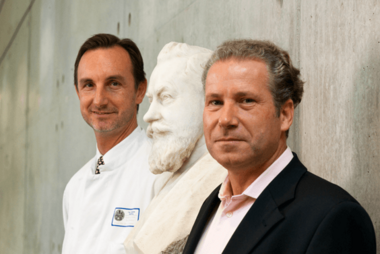“I’m incredibly proud”

Interview with HIT directors Prof. Thomas Haberer and Prof. Jürgen Debus
What are your feelings as you think about the official dedication of the gantry on Monday?
Debus: It has been an unbelievable launch. For me, it has been like the birth of a baby – although the pregnancy was considerably longer. Haberer: I’m incredibly proud, since we have collaborated with the GSI Helmholtz Center for Heavy Ion Research on the development of the gantry for 15 years and managed to stay within our budget of 119 million euros.
HIT was opened in November 2009. Why did it take nearly three years to start up the gantry?
Debus: From the very beginning, plans did not call for HIT to be completed as a turnkey project, like a house, for instance. Getting a system that is so technically and medically sophisticated up and running takes time. We also had to train the staff and perform quality assurance. Haberer: Because we participated in HIT’s technological development, we were able to continue refining the procedures since the first two treatment rooms were put into operation two years ago. At the same time, we optimized the third treatment room in the gantry.
When will the first patient be treated in the gantry?
Debus: The first three patients with brain tumors have already undergone treatment, and have each been irradiated six times. This means that their radiotherapy is complete for the time being. One patient has a tumor at a very critical site, between the optic nerves of the eyes. When treating this patient, it is especially important to aim the beam accurately. The gantry allows us to do this, since it rotates around the patient.
How many patients do you plan to treat in the gantry in the future?
Debus: This third room has exactly the same capacity as the two horizontal treatment rooms. This means that we are able to treat close to 300 patients here each year. We have treated nearly 1,000 patients altogether to date. Haberer: We perform radiotherapy in the three rooms 16 hours a day, 300 days a year.
Can children also benefit from the new treatment room?
Debus: This type of irradiation is especially well suited for treating children, for instance, if they have a spinal cord tumor or a brain tumor, because the beam takes the shortest route to the tumor and spares the tissue in an ideal manner. And since we need a lower radiation dose, the patient notices fewer side-effects.
Irradiation at HIT is substantially more expensive than conventional radiotherapy. Who pays for treatment and how is it worthwhile for Heidelberg University Hospital?
Debus: Treating a patient, who is irradiated 15 to 20 times, costs 20,000 euros, whether they undergo the radiotherapy in the horizontal rooms or in the gantry. Of course, this is also a question that needs to be put to the group of payers as a community of solidarity. But fortunately, we live in a country where every insured person gets the best possible treatment. Haberer: We have an agreement with the health insurers. The 20,000 euros per patient reimbursed by the insurers just covers the hospital’s costs. While HIT is not out to make a hefty profit, it doesn’t want to make a loss either. On the other hand, costs in this range are not all that unusual for cancer treatment, and many cancer drugs are very expensive as well.
HIT is the world’s first facility to have a rotating gantry, which makes it interesting for research. What studies are planned?
Haberer: We will be conducting a large number of studies and will be comparing the treatment results with those obtained with conventional radiotherapy. After all, the gantry is the only facility of its kind in the world. Of course, we will also perform a cost-benefit analysis. We can use protons as well as helium, oxygen and carbon ions for radiotherapy in all three rooms. Currently, for instance, we are studying how cell cultures react when they are irradiated with oxygen ions.
What plans do you have for the future of the gantry?
Haberer: We want to continue refining the quality and speed of irradiation. Debus: We are working on this continuously, and all of the findings benefit the patients very quickly, because HIT is directly integrated in the hospital.
Interview with the Rhein-Neckar-Zeitung on October 27.